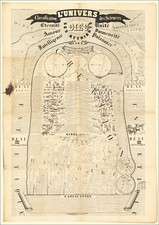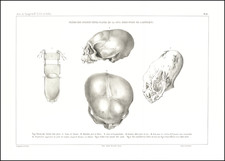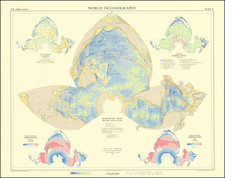This recognition poster titled Martin 2-0-2, prepared by the Ministry of Supply and promulgated by various branches of the British government including the Admiralty, War Office, and Air Ministry in November 1950, provides detailed illustrations and descriptions of the 2-0-2 aircraft created by the Glenn L. Martin Company. The Martin 2-0-2, designed in response to the Air Transport Association's specification A-1, was intended for medium-range routes and featured a unique low-wing monoplane design with all-metal construction, retractable nosewheel type undercarriage, and two Pratt & Whitney R-2800 CA 18 Double-Wasp aero-engines driving three-bladed Hamilton Standard reverse-pitch braking propellers.
The Martin 2-0-2's development began in 1945, just after the conclusion of World War II, a period marked by rapid advances in aviation technology and the burgeoning growth of commercial air travel. The aircraft's first flight on November 22, 1946, symbolized the shift from war-focused manufacturing to the creation of civilian transportation capable of high cruising speeds on medium-range routes. The 2-0-2 model accommodated 36 to 40 passengers or up to 20,000 lb. of freight, reflecting the multifaceted needs of the post-war economy.
With a maximum speed of 270 knots at 14,000 feet and a cruising speed of 234 knots at 12,000 feet, the aircraft's technical specifications epitomized the era's engineering achievements. The poster's inclusion of both passenger and cargo versions, along with the details about the "windmill-blade" propellers and the specifications for the upgraded Martin 4-0-4 model, demonstrates the versatile and evolving nature of aviation design at the time.
The Martin 2-0-2's introduction into service with numerous U.S. and foreign airlines marked a significant step in the growth of global commercial aviation. Its design, accommodating both passengers and substantial freight, epitomized the blend of functionality and innovation characteristic of the era.
In sum, the Martin 2-0-2 recognition poster serves as a detailed technical document, highlighting an aircraft that played a role in the expanding post-war commercial aviation landscape. Its combination of innovative design, adaptability to both passenger and cargo needs, and the provision for future improvements illustrates the dynamic nature of mid-20th-century aviation technology and industry.









![[ Esso Motor Oil Company Advertising Posters - Spy Belgium]](https://storage.googleapis.com/raremaps/img/small/98397.jpg)
![[The centre of this Slider is to be placed by a Thread or Pin over the centre of the respective Planisphere for any Operation]](https://storage.googleapis.com/raremaps/img/small/65557.jpg)



![(Early Philadelphia Architectural Drawings) Plan of the ceiling of St. Andrews Church [with two additional drawings on another sheet]](https://storage.googleapis.com/raremaps/img/small/90443.jpg)